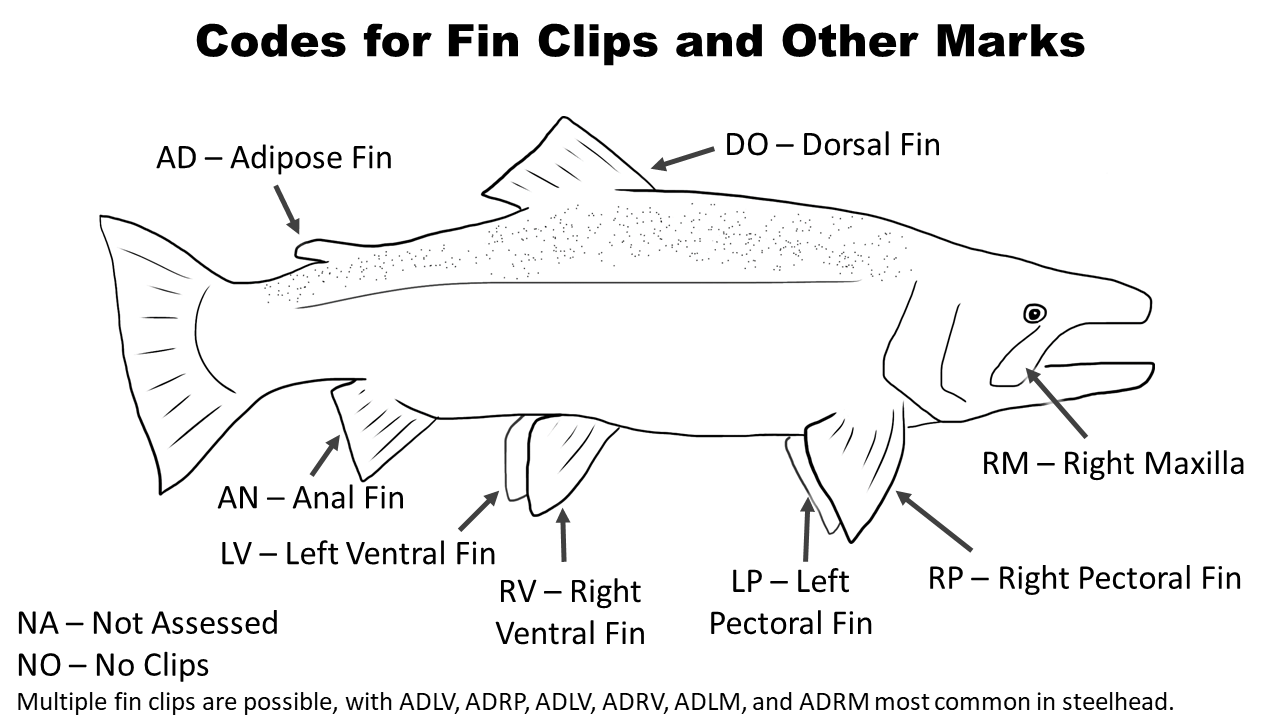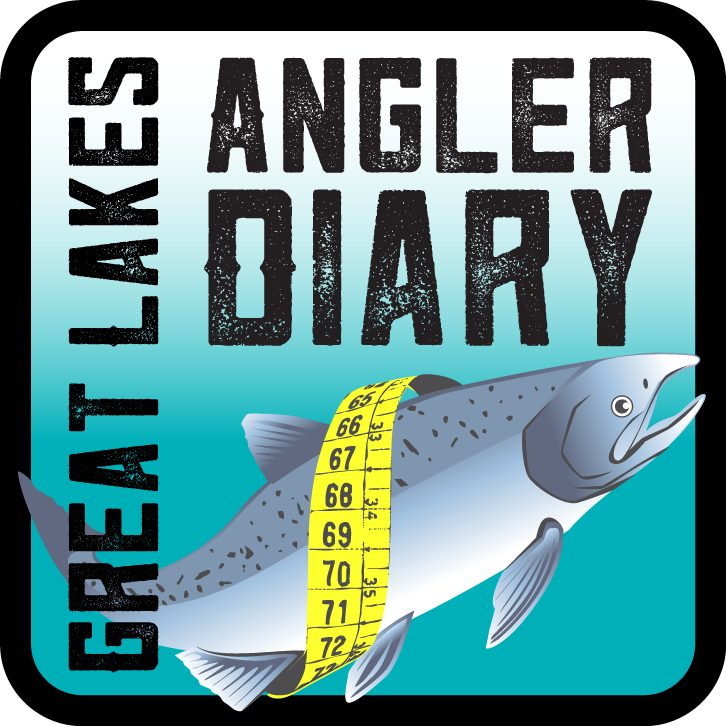Interpreting steelhead fin clips in Michigan streams: Update for the 2024 spring run
This year marks the first time that nearly all returning steelhead stocked in Michigan will have a fin clip, but out-of-state strays and stocking of unmarked rainbow trout will complicate interpretation on some rivers.

Since 2018, all yearling steelhead stocked in Michigan waters have been marked with a fin clip as part of the Great Lakes Mass Marking Program. Steelhead spend up to six years feeding and growing in the Great Lakes, so unmarked steelhead stocked before 2018 have aged out of the population.
This means that, for the most part, anglers can now identify wild steelhead by the absence of fin clips. However, we still have much to learn about how often stocked and wild steelhead stray from their river of origin, and this can have a dramatic effect on some rivers.
The Michigan River Steelhead Program engages anglers in collecting data on clipped and unclipped steelhead using the Great Lakes Angler Diary. A recent progress report from the steelhead program includes a synopsis of steelhead stocking and marking from the Great Lakes Fish Stocking Database and Michigan DNR’s Fish Stocking Database. Answers to frequently asked questions below are based on these databases and the progress report.
Have any unmarked steelhead been stocked in Michigan?
Yes, but the only unmarked steelhead stocked in Michigan waters since 2018 were fall fingerlings stocked in two Lake Superior tributaries (Anna River and Carp River). Fall fingerlings have lower survival than yearlings.
Unmarked Eagle Lake rainbow trout are also stocked in some rivers. These unclipped trout are typically 10-13 inches long after being stocked in spring and growing for one summer in the river environment. Rainbow trout and steelhead are the same species and it is not always possible to distinguish between the two.
Unmarked Eagle Lake rainbow trout are stocked annually in the Muskegon River in popular steelhead water from Croton to Newaygo. Eagle Lake rainbows stocked into other steelhead rivers like the Rogue, AuSable, and Clinton rivers are stocked upstream of steelheading water, but may migrate downstream.
Most Eagle Lake rainbow trout remain in the river after stocking, and most steelhead migrate to Lake Michigan to feed for at least one summer before returning to spawn. There are plenty of exceptions, though. Male steelhead, in particular, may remain in the river after stocking and mature without ever leaving the river to feed in the Great Lakes.
Have any unmarked steelhead been stocked in Great Lakes waters outside of Michigan?
Yes, unmarked steelhead have been stocked in out-of-state waters of the Lake Erie, Lake Huron, and Lake Michigan basins.
Roughly 1.7 million yearling-equivalent steelhead are stocked without marks each year in Lake Erie basin tributaries of Ohio, Pennsylvania, New York, and Ontario, with around 64,000 adipose-clipped steelhead stocked annually by Michigan in the Huron River.
An earlier study found that over half of the steelhead returning to the Huron River in 2009 and 2010 were strays from out of state. Based on that study, we expect to see many unclipped steelhead from out-of-state stockings show up in the Huron River. These unclipped stockers might also show up outside of the Lake Erie basin and contribute to runs in other rivers, with the Clinton River being the most likely.
In the Lake Michigan basin, around 10% of steelhead stocked 2018-2021 were unmarked. Unmarked steelhead were stocked in Wisconsin, Illinois, and Indiana because of pandemic restrictions that prevented marking of many steelhead stocked in 2020 and 2021.
Unmarked Skamania were stocked in Indiana waters of the St. Joseph River during 2021. These fish are particularly likely to be caught in Michigan waters since steelhead must pass through fish ladders at Berrien Springs and Niles before reaching Indiana waters. Skamania are also known to stray into other river systems including the Grand and Muskegon.
Unmarked steelhead yearlings stocked into Ontario waters accounted for 3.2% of all yearlings stocked in the Lake Huron basin from 2018-2021. Ontario also stocked 182,285 fall fingerlings and 153,000 fry without marks into the Lake Huron basin during this timeframe.
Do all steelhead with an adipose fin clip also have a coded wire tag (CWT) in their snout?
No, and the odds of having a CWT depend on the location.
Anglers are encouraged to submit heads or snouts from adipose-clipped steelhead because many of these fish have microscopic wire tags that can be extracted and read in the laboratory. Heads are picked up from freezers at drop sites around Michigan.
Some sites are closed during winter months, so check ahead before dropping off heads. Be sure to include a Coded Wire Tag Recovery Form (available online) in a bag with each head that you submit. If your fish has a CWT, you will receive a letter from DNR with details on when and where your fish was stocked!
Be aware that many adipose-clipped steelhead do not have a CWT, though, so there is a chance that your letter will indicate that no tag was found.
In the Lake Michigan basin, around 10% of adipose-clipped steelhead do not have a CWT. In the Lake Huron basin, over 40% of adipose-clipped steelhead do not have a CWT. This is mostly due to Ontario’s stocking of yearlings with an adipose clip and no CWT.
Funding has always been a factor in determining which species and locations are marked with CWTs and fin clips. The Great Lakes Mass Marking Program has focused on steelhead in the U.S. waters of Lake Huron and Lake Michigan in recent years. Funding has not been available for CWTs for Lake Superior, Lake Erie and Lake St. Clair tributaries.
This means that adipose-clipped steelhead caught in the Clinton River, Huron River, and Lake Superior streams are not likely to have CWTs. Even so, there is a chance of finding a stray fish from outside the basin that would provide useful information.
What marks have been used besides CWTs and adipose fin clips? 
The only other mark used on steelhead stocked by Michigan DNR is the right ventral fin clip. The right ventral fin clip has been used in combination with an adipose fin clip (ADRV) for Skamania stocked in the Manistee River. Some Skamania stocked in both the Manistee River and Indiana waters of the St. Joseph River in 2021 had only the right ventral (RV) clipped.
Wisconsin DNR uses a variety of marks and mark combinations on different steelhead strains stocked in different rivers. In addition to AD, ADRV, and RV marks used in other states there are several marks and mark combinations that are unique to Wisconsin. These include left ventral fin clips alone or in combination with adipose fin clips (LV, ADLV) and marks involving the upper jaw (a.k.a. maxilla).
If you catch a steelhead with a maxilla clip, it is a sure sign that your fish was stocked in Wisconsin. However, hook wounds can sometimes be mistaken for maxilla clips so be sure to take a picture for verification that your fish strayed from Wisconsin waters. Wisconsin has used left maxilla (LM) and right maxilla (RM) clips in recent years along with ADLM and ADRM combination clips.
One mark that hasn’t been used by government agencies recently is the pectoral fin clip. Anglers sometimes catch steelhead with deformed or damaged pectoral fins that are mistaken for fin clips. I have also seen some photos of fish with pectoral fins completely absent in a way that suggests a fin clip and have heard reports of anglers and fishing clubs marking fish that are not reported into stocking databases. This is very much discouraged since it further complicates interpretation.
Some anglers using the Great Lakes Angler Diary have also reported dorsal fin clips, which are not used to mark steelhead. Hatchery-reared steelhead often exhibit folded or deformed dorsal fins that are still noticeable in adult fish. However, some hatchery reared steelhead develop perfect fins and a few wild steelhead exhibit damaged or deformed dorsal fins. If dorsal fins provided a sure way to identify stocked fish, there would be less of a need for fin clips.
We are not asking all Great Lakes Angler Diary users to record information on dorsal fins, but some anglers have expressed a particular interest in reporting dorsal fin data. If you would like to record folded or deformed dorsal fins as marks either alone (D) or in combination with an adipose fin clip (ADD), please contact me directly for additional instructions.
How can I get involved? 
Michigan Sea Grant launched the Michigan River Steelhead Project in 2020 to allow steelhead anglers to report their catches online. By recording fin clips and lengths for every steelhead you catch, you can help biologists learn more about how natural reproduction and stocking contribute to fishing success in rivers around Michigan.
It is not too late to sign up online and record data for trips taken from now to the end of the spring run. Catches can be recorded using the Great Lakes Angler Diary website or apps for iOS and Android. A dashboard feature allows you to quickly calculate % unclipped, catch rate, and the average size of fish you catch, so don’t forget to update your app if you are already participating!
Fishery professionals with Michigan DNR and other agencies regularly participate in Zoom meetings to share updates with anglers as part of this project. Once you are signed up for the program, you’ll be added to the mailing list for our next meeting, which is scheduled for Monday, December 11 from 7:00-8:30 p.m. The online meeting will also include fishing reports from teams around the state.
Michigan Sea Grant helps to foster economic growth and protect Michigan’s coastal, Great Lakes resources through education, research and outreach. A collaborative effort of the University of Michigan and Michigan State University and its MSU Extension, Michigan Sea Grant is part of the NOAA-National Sea Grant network of 34 university-based programs.
This survey report was prepared by Michigan Sea Grant Extension Educator Daniel O’Keefe under award NA180AR4170102 and SUBK00013473 from the National Oceanic and Atmospheric Administration, U.S. Department of Commerce through the Regents of the University of Michigan. The statement, findings, conclusions, and recommendations are those of the author(s) and do not necessarily reflect the views of the National Oceanic and Atmospheric Administration, the Department of Commerce, or the Regents of the University of Michigan.



 Print
Print Email
Email

